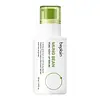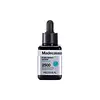What's inside
What's inside
 Key Ingredients
Key Ingredients

 Benefits
Benefits

 Concerns
Concerns

 Ingredients Side-by-side
Ingredients Side-by-side

Water
Skin ConditioningGlycerin
HumectantDipropylene Glycol
HumectantNiacinamide
SmoothingXylitol
Humectant1,2-Hexanediol
Skin ConditioningButylene Glycol
HumectantHydroxyacetophenone
AntioxidantAcrylates/C10-30 Alkyl Acrylate Crosspolymer
Emulsion StabilisingVigna Radiata Seed Extract
Skin ConditioningTromethamine
BufferingEthylhexylglycerin
Skin ConditioningHydrolyzed Gardenia Florida Extract
AntioxidantHydrolyzed Malt Extract
Skin ConditioningHydrolyzed Viola Tricolor Extract
Skin ProtectingMenthoxypropanediol
MaskingAdenosine
Skin ConditioningTrisodium Ethylenediamine Disuccinate
Pentylene Glycol
Skin ConditioningGlyceryl Glucoside
HumectantPunica Granatum Flower Extract
Skin ConditioningDextrin
AbsorbentHyaluronic Acid
HumectantGardenia Florida Fruit Extract
Skin ConditioningPhaseolus Radiatus Seed Extract
Skin ConditioningAnanas Sativus Fruit Extract
Skin ConditioningMalus Domestica Fruit Extract
AntioxidantPrunus Persica Fruit Extract
AbrasiveVaccinium Angustifolium Fruit Extract
Skin ProtectingGlycogen
HumectantAcetyl Hexapeptide-8
HumectantWater, Glycerin, Dipropylene Glycol, Niacinamide, Xylitol, 1,2-Hexanediol, Butylene Glycol, Hydroxyacetophenone, Acrylates/C10-30 Alkyl Acrylate Crosspolymer, Vigna Radiata Seed Extract, Tromethamine, Ethylhexylglycerin, Hydrolyzed Gardenia Florida Extract, Hydrolyzed Malt Extract, Hydrolyzed Viola Tricolor Extract, Menthoxypropanediol, Adenosine, Trisodium Ethylenediamine Disuccinate, Pentylene Glycol, Glyceryl Glucoside, Punica Granatum Flower Extract, Dextrin, Hyaluronic Acid, Gardenia Florida Fruit Extract, Phaseolus Radiatus Seed Extract, Ananas Sativus Fruit Extract, Malus Domestica Fruit Extract, Prunus Persica Fruit Extract, Vaccinium Angustifolium Fruit Extract, Glycogen, Acetyl Hexapeptide-8
Water
Skin ConditioningPropanediol
SolventDipropylene Glycol
HumectantNiacinamide
Smoothing1,2-Hexanediol
Skin ConditioningButyrospermum Parkii Butter
Skin ConditioningPanthenol
Skin ConditioningHydrolyzed Sponge
Skin ConditioningDiglycerin
HumectantHydroxyacetophenone
AntioxidantAmmonium Acryloyldimethyltaurate/Vp Copolymer
Glyceryl Glucoside
HumectantAcrylates/C10-30 Alkyl Acrylate Crosspolymer
Emulsion StabilisingArginine
MaskingPolyglyceryl-10 Laurate
Skin ConditioningHydrogenated Lecithin
EmulsifyingPolyglyceryl-10 Stearate
Skin ConditioningButylene Glycol
HumectantAdenosine
Skin ConditioningXanthan Gum
EmulsifyingMadecassoside
AntioxidantTrisodium Ethylenediamine Disuccinate
Pyrus Communis Fruit Extract
Skin ConditioningJuniperus Virginiana Oil
MaskingRosa Damascena Flower Water
MaskingGlucose
HumectantIris Florentina Root Extract
MaskingSimmondsia Chinensis Seed Oil
EmollientCucumis Melo Fruit Extract
Skin ConditioningPogostemon Cablin Leaf Oil
MaskingCentella Asiatica Extract
CleansingHedera Helix Leaf/Stem Extract
AntimicrobialFicus Carica Fruit Extract
HumectantCyperus Rotundus Root Extract
Skin ConditioningArtemisia Vulgaris Oil
PerfumingRosmarinus Officinalis Leaf Oil
MaskingCeramide NP
Skin ConditioningDiospyros Kaki Leaf Extract
Skin ProtectingEthylhexylglycerin
Skin ConditioningVitis Vinifera Fruit Extract
Skin ConditioningCarthamus Tinctorius Flower Extract
Skin ConditioningCoffea Arabica Seed Extract
MaskingPolygonum Cuspidatum Root Extract
AntioxidantCamellia Sinensis Leaf Extract
AntimicrobialCastanea Crenata Shell Extract
Skin ConditioningZanthoxylum Piperitum Fruit Extract
Skin ConditioningCitric Acid
BufferingWater, Propanediol, Dipropylene Glycol, Niacinamide, 1,2-Hexanediol, Butyrospermum Parkii Butter, Panthenol, Hydrolyzed Sponge, Diglycerin, Hydroxyacetophenone, Ammonium Acryloyldimethyltaurate/Vp Copolymer, Glyceryl Glucoside, Acrylates/C10-30 Alkyl Acrylate Crosspolymer, Arginine, Polyglyceryl-10 Laurate, Hydrogenated Lecithin, Polyglyceryl-10 Stearate, Butylene Glycol, Adenosine, Xanthan Gum, Madecassoside, Trisodium Ethylenediamine Disuccinate, Pyrus Communis Fruit Extract, Juniperus Virginiana Oil, Rosa Damascena Flower Water, Glucose, Iris Florentina Root Extract, Simmondsia Chinensis Seed Oil, Cucumis Melo Fruit Extract, Pogostemon Cablin Leaf Oil, Centella Asiatica Extract, Hedera Helix Leaf/Stem Extract, Ficus Carica Fruit Extract, Cyperus Rotundus Root Extract, Artemisia Vulgaris Oil, Rosmarinus Officinalis Leaf Oil, Ceramide NP, Diospyros Kaki Leaf Extract, Ethylhexylglycerin, Vitis Vinifera Fruit Extract, Carthamus Tinctorius Flower Extract, Coffea Arabica Seed Extract, Polygonum Cuspidatum Root Extract, Camellia Sinensis Leaf Extract, Castanea Crenata Shell Extract, Zanthoxylum Piperitum Fruit Extract, Citric Acid
 Reviews
Reviews

Ingredients Explained
These ingredients are found in both products.
Ingredients higher up in an ingredient list are typically present in a larger amount.
1,2-Hexanediol is a synthetic liquid and another multi-functional powerhouse.
It is a:
- Humectant, drawing moisture into the skin
- Emollient, helping to soften skin
- Solvent, dispersing and stabilizing formulas
- Preservative booster, enhancing the antimicrobial activity of other preservatives
Acrylates/C10-30 Alkyl Acrylate Crosspolymer is a synthetic polymer. It is used to thicken and improve the texture of products. Due to its properties, it can prevent water and oil ingredients from separating.
Adenosine is in every living organism. It is one of four components in nucleic acids that helps store our DNA.
Adenosine has many benefits when used. These benefits include hydrating the skin, smoothing skin, and reducing wrinkles. Once applied, adenosine increases collagen production. It also helps with improving firmness and tissue repair.
Studies have found adenosine may also help with wound healing.
In skincare products, Adenosine is usually derived from yeast.
Learn more about AdenosineButylene Glycol (or BG) is used within cosmetic products for a few different reasons:
Overall, Butylene Glycol is a safe and well-rounded ingredient that works well with other ingredients.
Though this ingredient works well with most skin types, some people with sensitive skin may experience a reaction such as allergic rashes, closed comedones, or itchiness.
Learn more about Butylene GlycolDipropylene Glycol is a synthetically created humectant, stabilizer, and solvent.
This ingredient helps:
Dipropylene glycol is technically an alcohol, but it belongs to the glycol family (often considered part of the ‘good’ alcohols). This means it is hydrating and gentle on skin unlike drying solvent alcohols like denatured alcohol.
As a masking agent, Dipropylene Glycol can be used to cover the smell of other ingredients. However, it does not have a scent.
Studies show Dipropylene Glycol is considered safe to use in skincare.
Learn more about Dipropylene GlycolEthylhexylglycerin (we can't pronounce this either) is commonly used as a preservative and skin softener. It is derived from glyceryl.
You might see Ethylhexylglycerin often paired with other preservatives such as phenoxyethanol. Ethylhexylglycerin has been found to increase the effectiveness of these other preservatives.
Glyceryl Glucoside is made from glycerol and glucose.
It is a humectant. Humectants help hydrate your skin by drawing moisture to it from the air.
Some foods that contain glyceryl glucoside include sake, miso, and wines.
Learn more about Glyceryl GlucosideHydroxyacetophenone is antioxidant with skin conditioning and soothing properties. It also boosts the efficiency of preservatives.
This ingredient is not irritating or sensitizing.
Niacinamide is a multitasking form of vitamin B3 that strengthens the skin barrier, reduces pores and dark spots, regulates oil, and improves signs of aging.
And the best part? It's gentle and well-tolerated by most skin types, including sensitive and reactive skin.
You might have heard of "niacin flush", or the reddening of skin that causes itchiness. Niacinamide has not been found to cause this.
In very rare cases, some individuals may not be able to tolerate niacinamide at all or experience an allergic reaction to it.
If you are experiencing flaking, irritation, and dryness with this ingredient, be sure to double check all your products as this ingredient can be found in all categories of skincare.
When incorporating niacinamide into your routine, look out for concentration amounts. Typically, 5% niacinamide provides benefits such as fading dark spots. However, if you have sensitive skin, it is better to begin with a smaller concentration.
When you apply niacinamide to your skin, your body converts it into nicotinamide adenine dinucleotide (NAD). NAD is an essential coenzyme that is already found in your cells as "fuel" and powers countless biological processes.
In your skin, NAD helps repair cell damage, produce new healthy cells, support collagen production, strengthen the skin barrier, and fight environmental stressors (like UV and pollution).
Our natural NAD levels start to decline with age, leading to slower skin repair, visible aging, and a weaker skin barrier. By providing your skin niacinamide, you're recharging your skin's NAD levels. This leads to stronger, healthier, and younger looking skin.
Another name for vitamin B3 is nicotinamide. This vitamin is water-soluble and our bodies don't store it. We obtain Vitamin B3 from either food or skincare. Meat, fish, wheat, yeast, and leafy greens contain vitamin B3.
The type of niacinamide used in skincare is synthetically created.
Learn more about NiacinamideTrisodium Ethylenediamine Disuccinate is used to help stabilize a product.
It is a chelating agent, meaning it helps prevent metal ions from binding to other ingredients. This prevents unwanted reactions in products. Metal ions can come into a product via the water ingredient. They are found in trace amounts and are not known to be harmful.
Water. It's the most common cosmetic ingredient of all. You'll usually see it at the top of ingredient lists, meaning that it makes up the largest part of the product.
So why is it so popular? Water most often acts as a solvent - this means that it helps dissolve other ingredients into the formulation.
You'll also recognize water as that liquid we all need to stay alive. If you see this, drink a glass of water. Stay hydrated!
Learn more about Water